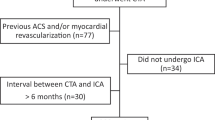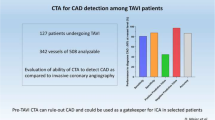Abstract
Patients undergoing TAVR undergo routine CT angiography (CTA) to assess aorto-iliac pathology and annular dimensions. While coronary CTA may exclude severe CAD in younger patients, its efficacy in defining CAD severity prior to TAVR may be limited. We retrospectively studied 50 consecutive patients undergoing both invasive coronary angiography (ICA) and routine pre-TAVR CTA. Severe CAD was defined as ≥50% stenosis by quantitative coronary angiography and compared to a blinded CTA visual estimation of ≥50% stenosis. The analysis was confined to four segments: left main and three proximal to mid major coronaries to maximize myocardial territory at risk. Coronary assessment was performed using standard reconstructed ECG phases from pre-TAVR chest CTA on a Philips 256 iCT scanner. Nearly ¾ of patients were ≥75 years old, 57% were female, half were diabetic and 45% had prior PCI. By ICA, 49% had significant coronary calcification. The incidence of severe proximal to mid vessel CAD by ICA was 39%. Similarly, a third of patients required PCI prior to TAVR. CTA was unable to exclude severe proximal to mid vessel CAD in 88% of patients in all four segments: non-diagnostic CTA readings were mainly due to calcification (60%) or motion artifact (28%). Non-diagnostic coronary CTA readings ranged from 25 to 72% according to segment analyzed: only the left main segment had diagnostic quality CTA in the majority of patients (p < 0.01). PCI is performed frequently prior to TAVR based upon invasive coronary angiographic assessment. Routine chest CTA algorithms do not provide adequate diagnostic information to exclude severe CAD, primarily due to severe coronary calcification in the TAVR population.




Similar content being viewed by others
References
Stefanini GG, Stortecky S, Wenaweser P, Windecker S (2014) Coronary artery disease in patients undergoing TAVI: why, what, when and how to treat. EuroIntervention 10(Suppl U):U69–U75
Rapp AH, Hillis LD, Lange RA, Cigarroa JE (2001) Prevalence of coronary artery disease in patients with aortic stenosis with and without angina pectoris. Am J Cardiol 87:1216–1217
Paradis JM, Labbe B, Rodes-Cabau J (2015) Coronary artery disease and transcatheter aortic valve replacement: current treatment paradigms. Coron Artery Dis 26:272–278
Hamdan A, Wellnhofer E, Konen E et al (2015) Coronary CT angiography for the detection of coronary artery stenosis in patients referred for transcatheter aortic valve replacement. J Cardiovasc Comput Tomogr 9:31–41
Andreini D, Pontone G, Mushtaq S et al (2014) Diagnostic accuracy of multidetector computed tomography coronary angiography in 325 consecutive patients referred for transcatheter aortic valve replacement. Am Heart J 168:332–339
Chieffo A, Giustino G, Spagnolo P et al (2015) Routine screening of coronary artery disease with computed tomographic coronary angiography in place of invasive coronary angiography in patients undergoing transcatheter aortic valve replacement. Circ Cardiovasc Interv 8:e002025
Harris BS, De Cecco CN, Schoepf UJ et al (2015) Dual-source CT imaging to plan transcatheter aortic valve replacement: accuracy for diagnosis of obstructive coronary artery disease. Radiology 275:80–88
Fihn SD, Gardin JM, Abrams J, et al. (2012) ACCF/AHA/ACP/AATS/PCNA/SCAI/STS Guideline for the diagnosis and management of patients with stable ischemic heart disease: a report of the American College of Cardiology Foundation/American Heart Association Task Force on Practice Guidelines, and the American College of Physicians, American Association for Thoracic Surgery, Preventive Cardiovascular Nurses Association, Society for Cardiovascular Angiography and Interventions, and Society of Thoracic Surgeons. J Am Coll Cardiol 60:e44–e164
Williams MC, Hunter A, Shah AS et al (2016) Use of Coronary computed tomographic angiography to guide management of patients with coronary disease. J Am Coll Cardiol 67:1759–1768
Andreini D, Pontone G, Ballerini G et al (2007) Feasibility and diagnostic accuracy of 16-slice multidetector computed tomography coronary angiography in 500 consecutive patients: critical role of heart rate. Int J Cardiovasc Imaging 23:789–801
Pontone G, Andreini D, Quaglia C, Ballerini G, Nobili E, Pepi M (2007) Accuracy of multidetector spiral computed tomography in detecting significant coronary stenosis in patient populations with differing pre-test probabilities of disease. Clin Radiol 62:978–985
Dewey TM, Brown DL, Herbert MA et al (2010) Effect of concomitant coronary artery disease on procedural and late outcomes of transcatheter aortic valve implantation. Ann Thorac Surg 89:758–767
Masson JB, Lee M, Boone RH et al (2010) Impact of coronary artery disease on outcomes after transcatheter aortic valve implantation. Catheter Cardiovasc Interv 76:165–173
Paradis JM, White JM, Genereux P et al (2017) Impact of coronary artery disease severity assessed with the SYNTAX score on outcomes following transcatheter aortic valve replacement. J Am Heart Assoc 6:e005070
van Mieghem NM, van der Boon RM, Faqiri E et al (2013) Complete revascularization is not a prerequisite for success in current transcatheter aortic valve implantation practice. JACC Cardiovasc Interv 6:867–875
Wenaweser P, Pilgrim T, Guerios E et al (2011) Impact of coronary artery disease and percutaneous coronary intervention on outcomes in patients with severe aortic stenosis undergoing transcatheter aortic valve implantation. EuroIntervention 7:541–548
Abramowitz Y, Banai S, Katz G et al (2014) Comparison of early and late outcomes of TAVI alone compared to TAVI plus PCI in aortic stenosis patients with and without coronary artery disease. Catheter Cardiovasc Interv 83:649–654
Abdel-Wahab M, Mostafa AE, Geist V et al (2012) Comparison of outcomes in patients having isolated transcatheter aortic valve implantation versus combined with preprocedural percutaneous coronary intervention. Am J Cardiol 109:581–586
Ronan G, Wolk MJ, Bailey SR et al (2014) ACCF/AHA/ASE/ASNC/HFSA/HRS/SCAI/SCCT/SCMR/STS 2013 Multimodality appropriate use criteria for the detection and risk assessment of stable ischemic heart disease: a report of the American College of Cardiology Foundation Appropriate Use Criteria Task Force, American Heart Association, American Society of Echocardiography, American Society of Nuclear Cardiology, Heart Failure Society of America, Heart Rhythm Society, Society for Cardiovascular Angiography and Interventions, Society of Cardiovascular Computed Tomography, Society for Cardiovascular Magnetic Resonance, and Society of Thoracic Surgeons. J Nucl Cardiol 21:192–220
Funding
This study was funded by Dr. Dauerman’s Research and Education Fund, which has contributions from multiple industry and university sources. There is no federal funding associated with this study.
Author information
Authors and Affiliations
Corresponding author
Ethics declarations
Conflict of interest
Dr. Dauerman is a consultant for Medtronic, Edwards and Boston Scientific and has Research grants from Boston Scientific, Edwards and Medtronic. Dr. Terrien is a consultant for Medtronic and Edwards. The other authors have no other relevant relationships to disclose.
Ethical approval
This article does not contain any studies with animals performed by any of the authors.
Informed consent
Informed consent was obtained from all individual participants included in the study for TAVR procedures—as this was a retrospective study, informed consent for retrospective data review was waived by the UVM.
Research involving with human and animal studies
All procedures performed in studies involving human participants were in accordance with the ethical standards of the institutional and/or national research committee and with the 1964 Helsinki declaration and its later amendments or comparable ethical standards.
Rights and permissions
About this article
Cite this article
Chava, S., Gentchos, G., Abernethy, A. et al. Routine CT angiography to detect severe coronary artery disease prior to transcatheter aortic valve replacement. J Thromb Thrombolysis 44, 154–160 (2017). https://doi.org/10.1007/s11239-017-1521-1
Published:
Issue Date:
DOI: https://doi.org/10.1007/s11239-017-1521-1




